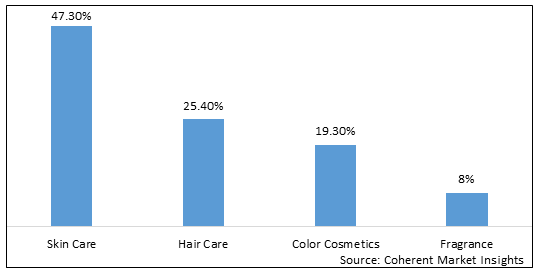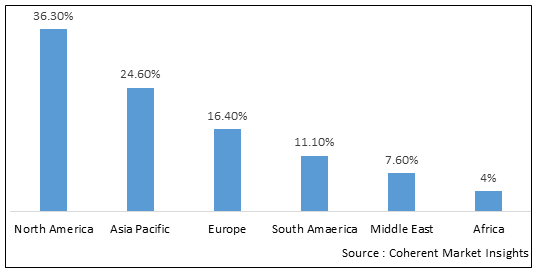Cosmetic Oem/Odm Market is estimated to be valued at USD 67.81 Bn in 2025 and is expected to reach USD 104.69 Bn in 2032, exhibiting a compound annual growth rate (CAGR) of 6.4% from 2025 to 2032. Cosmetic OEM/ODM manufacturers have extensive knowledge and expertise in the entire beauty and personal care products development and manufacturing process. OEM/ODM manufacturers provide finished products to beauty and personal care brands. Private labels and independent brands are mainly dependent on outsourcing for the manufacturing of their products. Increasing demand for private label and independent brands is driving more and more players to enter the full buy provider business model. According to Coherent Market Insights analysis, in FY 2021, the premium beauty and personal care products market reached a valuation of US$ 473.9 Billion and is likely to register a Y-o-Y growth rate of 4.0% in 2022, closing at US$ 495.28 Billion.
Global Cosmetic OEM/ODM Market- Impact of Coronavirus (Covid-19) Pandemic
The COVID-19 pandemic has impacted the global cosmetic OEM/ODM market with some challenges like decreased demand. Due to decreased consumer spending and as there are less social gatherings as a result of the pandemic, the demand for cosmetic products has decreased. For instance, in April 2020, Estee Lauder is an American multinational cosmetics company, a manufacturer and marketer of makeup, skincare, fragrance and hair care products, based in Midtown Manhattan, New York City. Estee Lauder reported an 11% drop in sales for the quarter due to the pandemic. Moreover, there is also a positive impact on increasing demand for personal care products. While the demand for cosmetic products has decreased, there has been an increased demand for personal care products such as hand sanitizers and disinfectants. For instance, in March 2020, LVMH, the parent company of brands such as Dior and Guerlain, shifted its production lines to produce hand sanitizer in response to the pandemic.
Global Cosmetic OEM/ODM Market - Drivers
There is a growing demand for personalized and natural cosmetics products, which is driving the growth of the global cosmetic oem/odm market. For instance, in 2020, the Korean cosmetics brand, Amorepacific, launched a personalized skincare brand, IOPELAB, which allows customers to create customized skincare products based on their skin type and concerns. This factor may propel the growth of the global cosmetic oem/odm market.
Consumers are becoming more aware of the ingredients used in cosmetic products and are concerned about product safety, which is driving the growth of the global cosmetic oem/odm market. For instance, in 2019, Johnson & Johnson announced that it would stop selling talc-based baby powder in the U.S. and Canada due to concerns about the safety of the product. This factor may drive the growth of the cosmetic oem/odm market.
Increasing Disposable Income in Emerging Markets
The increasing disposable income in emerging markets is driving the growth of the global cosmetic oem/odm market, as consumers have more money to spend on cosmetic products. For instance, in 2019, Loreal reported strong sales growth in emerging markets such as India and Indonesia.
Global Cosmetic OEM/ODM Market - Restraints
Developing and manufacturing cosmetic products can be costly and time-consuming. Cosmetic oem/odm companies must invest in research and development, production facilities, and equipment, which can be expensive. Additionally, meeting tight deadlines and keeping up with consumer demands can be challenging, which can impact the quality of the products. Moreover, stringent regulations are also a hinder factor for the global cosmetic oem/odm market. The cosmetic industry is highly regulated, and manufacturers must comply with various regulations related to product safety, labelling, and ingredient restrictions. For instance, the European Union has banned over 1,300 ingredients in cosmetic products, which can limit the types of products that can be manufactured and marketed. This factor may hinder the growth of the global cosmetic oem/odm market.
Among product type, skin care segment held a significant market share in 2025 in the global cosmetic OEM/ODM market. This is attributed to the increasing demand for lotions, moisturizers, and body wash among others. According to The Cosmetic Toiletry & Perfumery Association 2017 report, Cosmetics Europe - the personal care association, regularly reports on the European cosmetics market which, in 2021, was worth EUR €80 billion at Retail Sales Price (RSP) making Europe and the USA the largest cosmetics markets in the world (Europe 2020 - EUR €76.7 billion RSP). The report also stated that the skin care industry in the U.K witnessed a growth of 3.1% in 2019 and reached US$ 4.50 billion in December 2019, from US$ 2.30 billion in December 2018.
Figure 1. Global Cosmetic OEM/ODM Market, By Product, 2025

To learn more about this report, Download Free Sample
Hair care product includes products like shampoos, conditioners, and hair masks. Hair care products have also experienced significant growth in the global cosmetic oem/odm market, as consumers are increasingly focused on maintaining healthy and lustrous hair.
Global Cosmetic OEM/ODM Market - Regional Insights
The North America region is the largest market share with 36.30 % in the global cosmetic oem/odm market in 2025. The region is home to some of the world’s leading cosmetic companies and has a large consumer base that is willing to pay a premium for high-quality products. For instance, North America cosmetic oem/odm market was valued at US$ 9.2 billion in 2020.
Among regions, Asia Pacific is also a significant player in the global cosmetic oem/odm market, accounting for a market share of 24.60% in 2025. This is attributed to the growing beauty and personal care industry in the region. For instance, according to the Personal Care & Cosmetics Products Country Guide: Australia, published by the U.S. Department of Commerce in 2016, Australia’s Revenue in the Beauty & Personal Care market amounts to US$6.79bn in 2023. The market is expected to grow annually by 2.76% (CAGR 2025-2032. The market's largest segment is the segment Personal Care with a market volume of US$2.73bn in 2023. Moreover, the report also states that the average annual spending on cosmetics in Australia is US$ 146 and US$ 223 in Japan, as compared to US$ 139 in the U.S.
Cosmetic OEM/ODM Market Report Coverage
| Report Coverage | Details | ||
|---|---|---|---|
| Base Year: | 2024 | Market Size in 2025: | USD 67.81 Bn |
| Historical Data for: | 2020 To 2024 | Forecast Period: | 2025 To 2032 |
| Forecast Period 2025 to 2032 CAGR: | 6.4% | 2032 Value Projection: | USD 104.69 Bn |
| Geographies covered: |
|
||
| Segments covered: |
|
||
| Companies covered: |
Intercos S.p.A., Kolmar Korea Co. Ltd., Scalpi Cosmética sa, Cosmecca Korea Co., Cosmax Inc., Mana Products Inc., KBL cosmetics Ltd., Urist Cosmetics Incorporated, Fareva Holding SA, Milliona Cosmetics Co., Ltd., Skinlys, Maesa SAS, Schwanhäußer Holding GmbH & Co. KG, Tricorbraun Inc., Herrco Cosmetics Limited, Architectural Beauty, Allure Labs Inc., Case Mason Filling, Inc., Pardaco Trading Pte Ltd, and KDC/ONE among others. |
||
| Growth Drivers: |
|
||
| Restraints & Challenges: |
|
||
Uncover macros and micros vetted on 75+ parameters: Get instant access to report
Global Cosmetic OEM/ODM Market - Recent Developments
Figure 2. Global Cosmetic OEM/ODM Market, By Region, 2025

To learn more about this report, Download Free Sample
Global Cosmetic OEM/ODM Market – Key Players
Major players operating in the global cosmetic OEM/ODM market include Intercos S.p.A., Kolmar Korea Co. Ltd., Scalpi Cosmética sa, Cosmecca Korea Co., Cosmax Inc., Mana Products Inc., KBL cosmetics Ltd., Urist Cosmetics Incorporated, Fareva Holding SA, Milliona Cosmetics Co., Ltd., Skinlys, Maesa SAS, Schwanhäußer Holding GmbH & Co. KG, Tricorbraun Inc., Herrco Cosmetics Limited, Architectural Beauty, Allure Labs Inc., Case Mason Filling, Inc., Pardaco Trading Pte Ltd, and KDC/ONE.
*Definition: OEM, which stands for "Original Equipment Manufacturer" in the cosmetics industry, denotes ownership of the design and formulation of a specific product. Additionally, there are terms like "private label," where the OEM is the brand's original creator. As an alternative, Original Design Manufacturing firms develop the general layout and technical specifications of the products that the cosmetic companies market under their brands.
Share
Share
Missing comfort of reading report in your local language? Find your preferred language :
Transform your Strategy with Exclusive Trending Reports :
Frequently Asked Questions
Select a License Type
Joining thousands of companies around the world committed to making the Excellent Business Solutions.
View All Our Clients